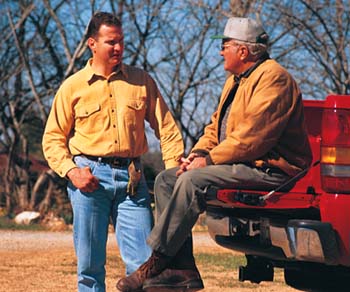A Growing Business – The Changing Face of Alabama’s Family Farms

Standing in the equipment shed on his Talladega County farm, Bob Luker can’t help but marvel at how much agriculture has changed since his dad started farming. On one side of the young farmer sits a 235-horsepower, $140,000 tractor he uses to pull a 12-row planter; on the other is an 80 horsepower tractor his father purchased almost 40 years ago for $1,800.Although Luker still uses both machines, the stark contrast in their size and expense paints a dramatic picture of how family farms in Alabama have changed.”Back in the ’70s, my dad farmed between 400 and 500 acres,” Bob recalled. “He grew soybeans and a little bit of wheat, and he was able to pay the family living expenses, pay for his equipment and even buy some land. Now, I’m farming about 1,500 acres, and I’ve had to diversify into corn and cotton. My wife and I are having to farm about three to four times as much land as he did to have the same standard of living.”It’s a story Dr. Robert Taylor, Alfa’s eminent scholar in agricultural economics at Auburn University, has heard time and again.”What constitutes a family farm is changing, especially when you’re talking about major commodities,” Taylor said. “What’s driving this is largely economies of scale. More expensive equipment and lower commodity prices are pushing them to go to that larger size.”Those who are not willing to accept the slim profit margins and financial risk associated with farming, Taylor added, have chosen to pursue other careers. As a result, the number of Alabama farms has decreased from more than 250,000 in 1930 to fewer than 50,000 today.Bob’s father, Robert, said the economic pressures to farm more land were present even in his grandfather’s day.”My grandfather bought this farm in 1918, and he farmed it with two mules and fed his family,” Mr. Luker recalled. “After my father took it over, he couldn’t survive off the 45 acres, so he had to rent another 20 from an uncle. By the time I started farming in 1959, I had to work 500 acres with another man to have the same quality of living.”Propped against the John Deere 8400 tractor Bob uses to pull his planter, the Lukers said it’s easy to see why family farms had to get larger. The tractor, they explained, cost more than Mr. Luker’s whole farming fleet, but today’s commodity prices actually are lower than when he began farming.”In 1946, when I came home from the service, my father was still farming, and we sold corn out of the crib for $3.25 a bushel–and that was back when a quarter was as big as a wagon wheel. Now, it’s $1.99 a bushel at harvest time,” Mr. Luker said. “When I was growing soybeans, we averaged about $7.50 a bushel, and I sold seed beans for as much as $12-$14. Now the price of soybeans runs from $4-$4.10 a bushel.”Taylor said the current trends in agriculture, however, aren’t altogether bad–at least not for consumers.”From a very long-term standpoint, agricultural research and increases in productivity have allowed people to move off the farm and pursue other (career) options,” Taylor said. “As citizens, we’ve all benefited from that because we aren’t tied to the land–to produce food to feed our families.”Still, Bob says many people don’t understand that his 1,500-acre operation is a family farm.”I know a lot of people have a view that a farm is 40 acres, seven or eight cows, some chickens and a horse, and in some respects they are right. But I certainly don’t consider myself a ‘corporate’ farmer,” he said.”This past year, I farmed with my labor; my wife helped on things she could help with; and my dad volunteered when he could,” Bob added. “This is a family farm; it supports this family. The only income we have is from farming. If we had less acres, I don’t know if I could justify my fixed costs anymore.”That’s why, like most Alabama farmers, Bob is closely following this year’s farm bill debate in Washington. Farm organizations like the Alabama Farmers Federation are encouraging lawmakers to approve a safety net that would protect farmers like the Lukers when prices are low. Without such a program, it’s likely more farmers will opt to sell their equipment and find public jobs with better pay and shorter hours. If that happens, Bob said Americans could one day find themselves relying on other countries to produce their food and fiber.”If we get dependent upon other countries for our food, it could be like gas was in the ’70s with OPEC, and I know that people wouldn’t want to go in the grocery store and pay $7-$8 for a loaf of bread,” Bob said. “You know you can do without gas; you can always walk. But you can’t just not eat. You can only do that for so long.”
